Middle childhood, typically defined as ages 6-12, is a crucial period in a child’s development. During this stage, children experience significant cognitive and emotional growth that shapes their identity, their relationships, and how they navigate the world. As a parent, understanding the key developmental milestones in these areas can help you support and nurture your child’s growth effectively. This article will explore the cognitive and emotional changes that occur during middle childhood and provide practical tips for fostering healthy development at home.
Cognitive Development in Middle Childhood
Cognitive development in middle childhood is marked by several significant milestones that lay the foundation for more complex thinking. This period marks a shift from the more egocentric thinking of early childhood to the ability to think logically and critically about the world.
Cognitive Milestones
One of the most significant changes during this stage is the shift from concrete thinking to more logical reasoning. Children begin to think more systematically, solve problems with greater ease, and perform tasks that require attention and focus. They also develop a stronger ability to remember information, which contributes to their growing academic success.
Memory and attention span also improve considerably in middle childhood. As children grow, they become capable of processing and retaining more complex information. They may begin to engage in multi-step tasks, such as following a set of instructions or completing a puzzle, and they can focus for longer periods of time. This ability to concentrate and remember details is especially important in school and during extracurricular activities.
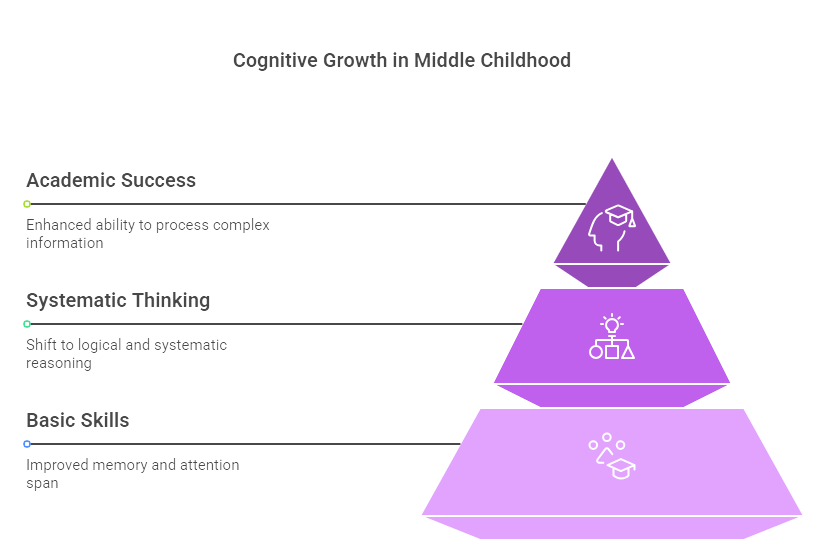
The Role of Education and Learning
School plays a vital role in supporting cognitive growth during middle childhood. It is during this stage that children begin to learn reading, writing, math, and other foundational skills. Teachers and educational environments foster attention, concentration, and problem-solving skills that are essential for their overall cognitive development.
Extracurricular activities also contribute to cognitive growth. Activities such as sports, music, and arts can enhance creativity, logical thinking, and even emotional intelligence. Providing children with a variety of learning opportunities helps stimulate their brains and broaden their thinking.
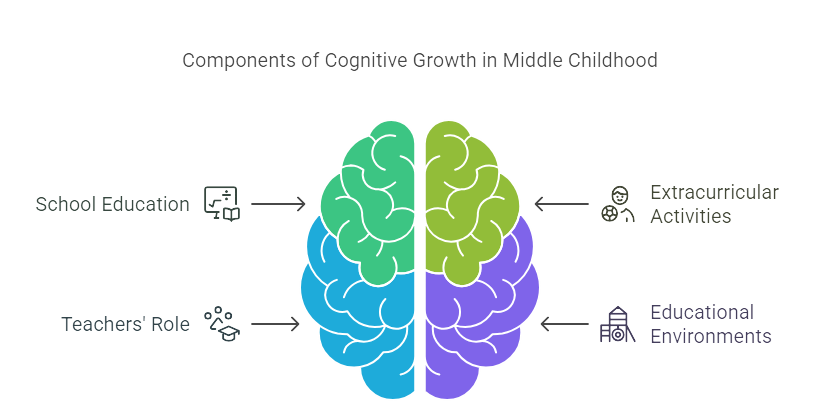
Critical Thinking and Cognitive Flexibility
As children enter middle childhood, their ability to engage in critical thinking increases. They begin to recognize that there are multiple perspectives on a situation and can reason through complex issues. Encouraging creativity, open-ended problem-solving, and discussion about different viewpoints can further develop this skill. Cognitive flexibility—the ability to adjust one’s thinking in response to new information—is also crucial during this stage. Parents can foster cognitive flexibility by encouraging their children to explore new interests, solve problems in different ways, and embrace change.
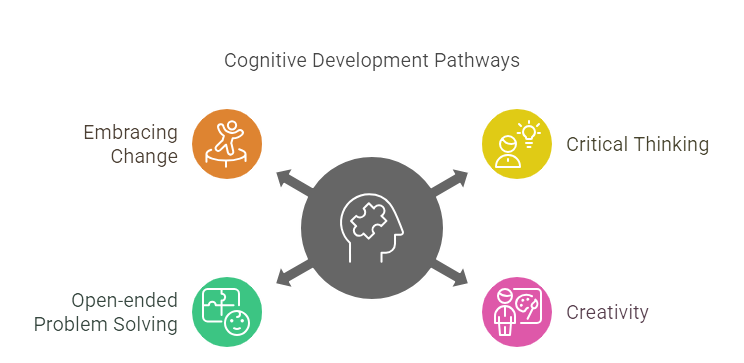
Emotional Development in Middle Childhood
Emotional development is just as important as cognitive growth during middle childhood. This stage marks significant strides in emotional regulation, self-awareness, and social understanding. As children begin to manage their feelings more effectively, they also develop stronger relationships with others.
Emotional Regulation
In middle childhood, children’s ability to understand and manage their emotions improves significantly. They become more aware of how their emotions affect their behavior and relationships. This growing self-awareness is essential for emotional regulation, which refers to a child’s ability to control their emotional responses to different situations.
Children in this age group are better equipped to handle frustration, anxiety, and other strong emotions. However, they still need guidance to help them navigate emotional challenges. Parents can support emotional regulation by helping children label their emotions, use calming strategies (like deep breathing or counting to ten), and find appropriate outlets for their feelings, such as drawing or physical activity.
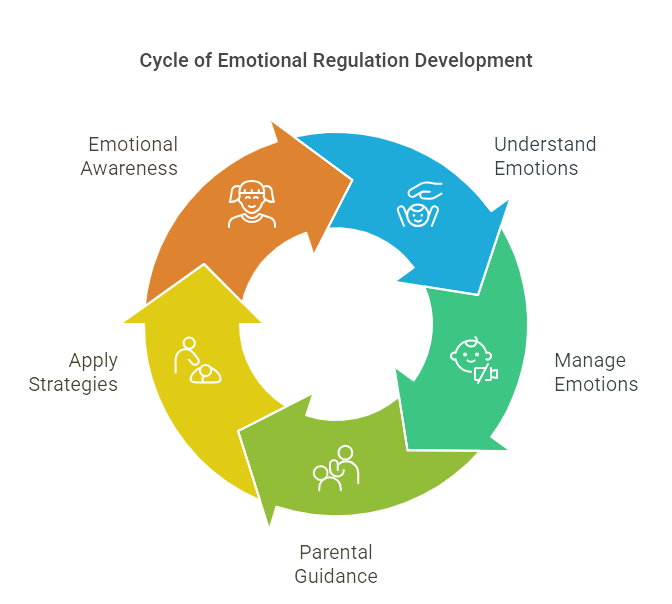
Developing Empathy
Empathy—the ability to understand and share the feelings of others—also begins to develop more fully during middle childhood. Children start to recognize that other people have feelings, thoughts, and perspectives that may differ from their own. They become more attuned to the emotions of those around them and begin to engage in acts of kindness, cooperation, and support.
Peer relationships play a significant role in fostering empathy. Children learn to navigate friendships, understand social cues, and resolve conflicts. Parents can encourage empathy by discussing how others might feel in different situations and modeling empathetic behavior. Encouraging cooperative play and teaching conflict resolution skills also helps children develop emotional intelligence.
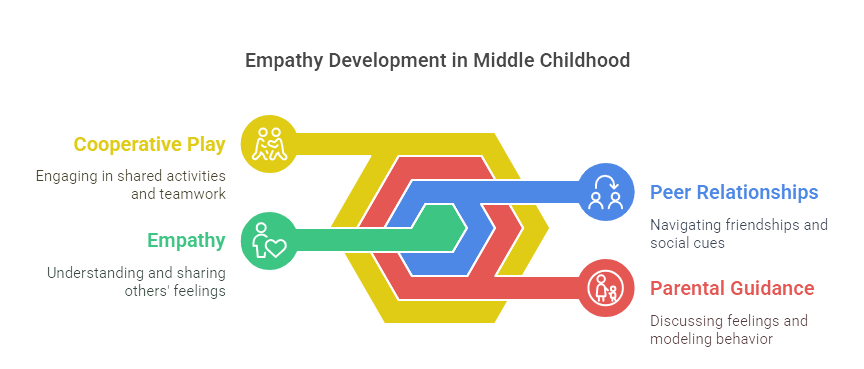
Self-Concept and Self-Esteem
As children enter middle childhood, they begin to form a stronger sense of self. This is when they start developing a more defined identity and begin to compare themselves to others. A child’s self-concept—the way they see themselves—becomes more nuanced, and they may start to think about their strengths, weaknesses, and abilities.
Self-esteem, or how a child feels about themselves, is closely tied to their sense of competence and how they are treated by others. Positive feedback from parents, teachers, and peers helps to build confidence and reinforce a positive self-image. On the other hand, negative feedback or lack of encouragement can affect a child’s self-esteem.
Parents can foster healthy self-esteem by acknowledging their child’s efforts, not just their outcomes. Encouraging a growth mindset—where effort and learning from mistakes are valued over innate talent—can also help children develop resilience and confidence.
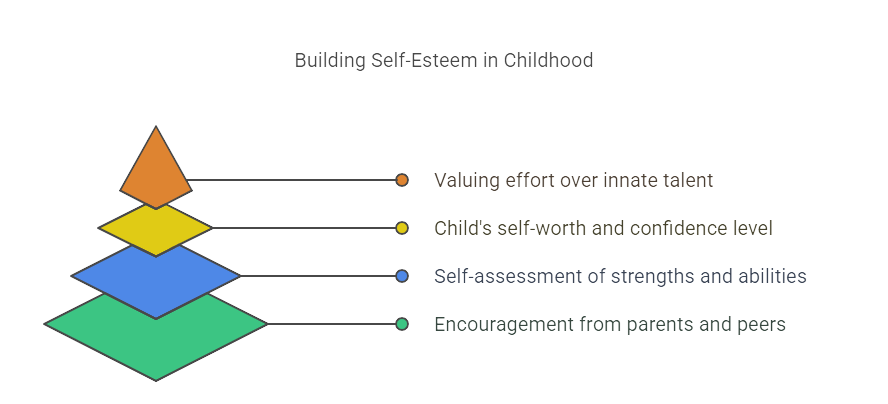
Social Development and Peer Relationships
Social development is another critical aspect of growth in middle childhood. As children interact with peers and adults outside of the family unit, they develop social skills that are essential for emotional well-being and future success.
Peer Influence and Friendships
Friendships become increasingly important during middle childhood. Peer relationships teach children essential social skills such as cooperation, negotiation, and conflict resolution. Children learn how to take turns, share, and empathize with their friends, which contributes to their emotional growth. As they navigate group dynamics and peer pressure, they also begin to form their own identities, separate from their family.
Parents should encourage healthy friendships by promoting inclusive behavior, supporting group play, and discussing how to be a good friend. It’s also important to monitor the quality of peer relationships and intervene when necessary, especially if a child is experiencing bullying or isolation.
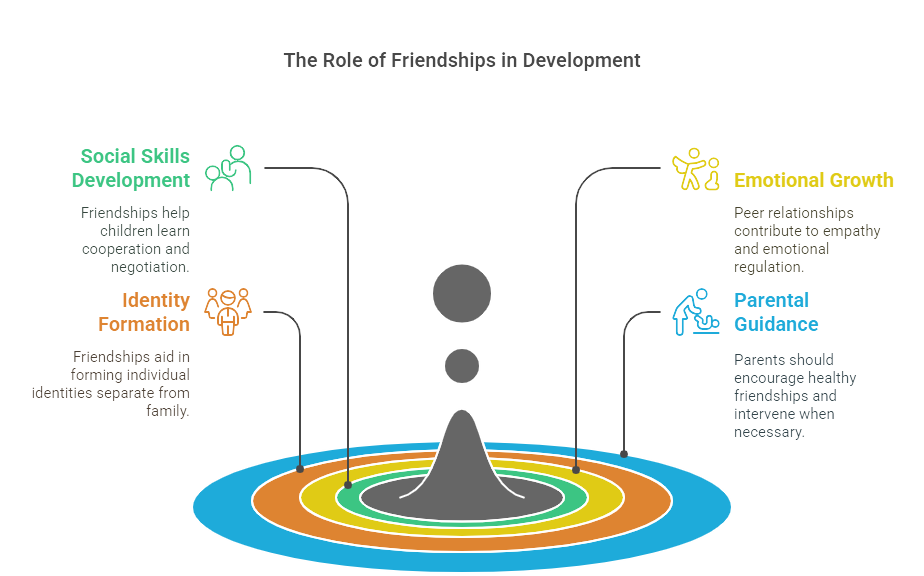
Impact of Family Dynamics
While peers become more influential, family dynamics still play a significant role in emotional development. The relationships children have with siblings and parents shape their emotional responses and overall mental health. A supportive and communicative family environment fosters emotional security, while unhealthy dynamics (such as conflict or neglect) can hinder emotional growth.
Parents can help strengthen emotional development by fostering open communication, promoting family bonding activities, and teaching children healthy ways to resolve conflicts.
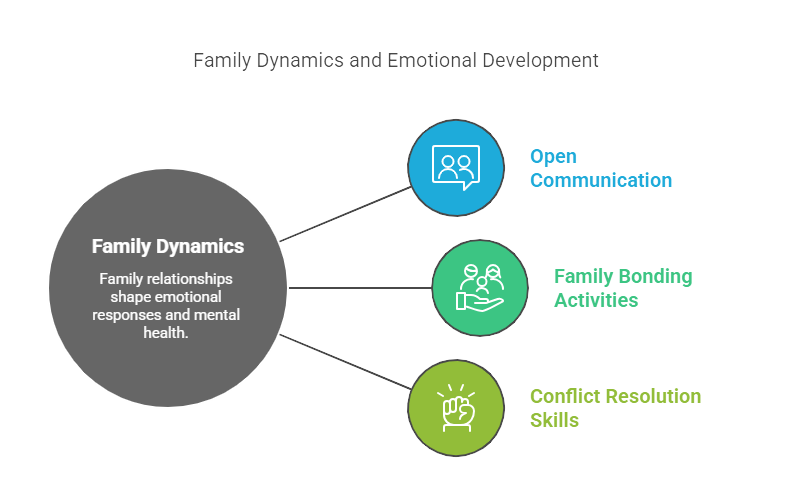
Supporting Cognitive and Emotional Growth at Home
Parents can create an environment that supports both cognitive and emotional growth in several key ways:
Creating a Stimulating Environment
Providing a variety of books, puzzles, educational toys, and activities that promote problem-solving helps stimulate cognitive development. Open-ended play, where children can explore their creativity and experiment with new ideas, is also crucial. At the same time, it’s important to ensure that children have quiet time for reflection and relaxation.
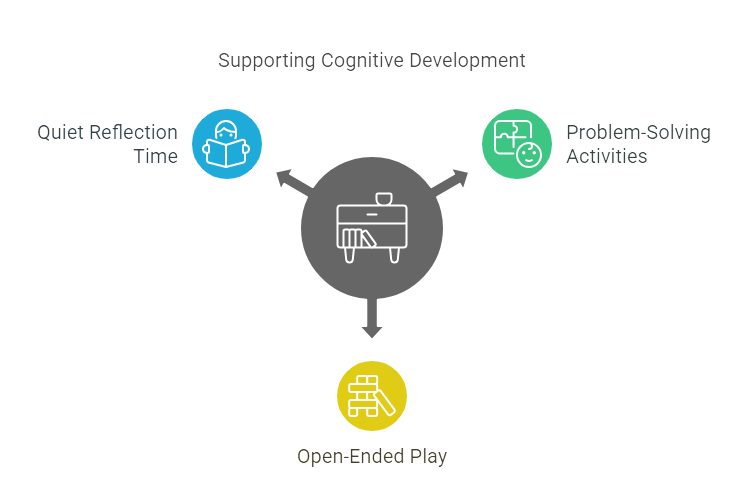
Modeling Emotional Intelligence
Parents are the primary role models for emotional intelligence. By modeling emotional regulation, empathy, and problem-solving in their own behavior, parents can teach their children these skills. Parents should also use everyday situations to teach emotional awareness—whether it’s discussing how a character in a book feels or reflecting on a challenging situation at school.
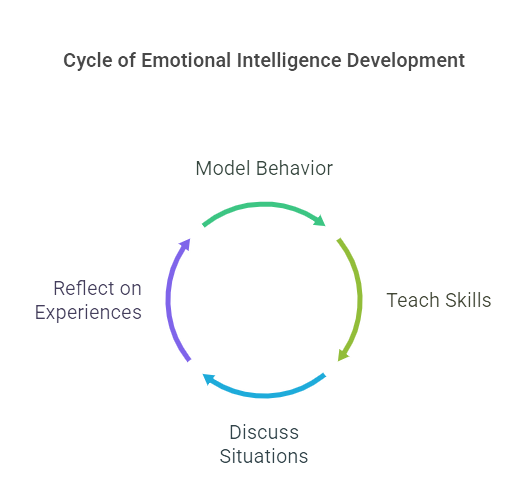
Setting Expectations and Providing Guidance
Setting clear, consistent expectations and providing appropriate challenges helps children build confidence. Encouraging children to take on new responsibilities and make decisions for themselves also fosters independence and emotional resilience. It’s essential for parents to balance offering support with allowing children to navigate challenges on their own.
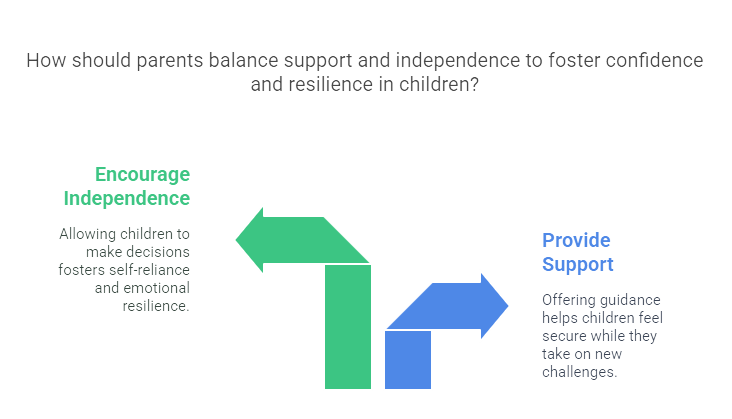
Common Challenges and How to Address Them
Children’s cognitive and emotional development isn’t always linear. Some children may experience delays or face challenges in these areas. Signs of cognitive delays may include difficulty focusing, struggling with problem-solving, or falling behind academically. Emotional challenges can manifest as frequent outbursts, social difficulties, or low self-esteem.
If parents notice any concerning behaviors or signs of developmental delays, it’s important to seek guidance from teachers, pediatricians, or child development specialists. Early intervention can help address issues before they become more significant challenges.
Balancing Technology Use
Technology can play a significant role in children’s cognitive development, but too much screen time can also hinder emotional growth and social skills. Parents should aim to find a healthy balance by encouraging offline activities and setting limits on screen time. Engaging children in face-to-face interactions and physical activities promotes both cognitive and emotional development.
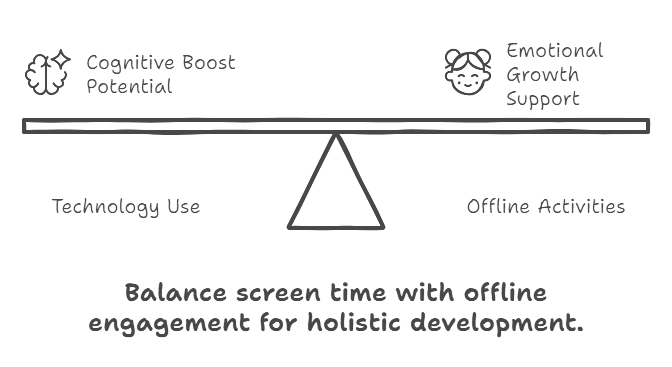
Conclusion
Middle childhood is a time of incredible cognitive and emotional growth. By understanding the milestones and challenges in these areas, parents can provide the support and guidance their children need to thrive. Fostering a nurturing environment at home—filled with opportunities for learning, emotional regulation, and social connection—can help children navigate this critical stage and build the foundation for a successful, emotionally healthy future.





